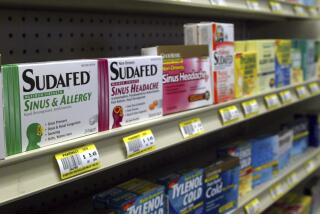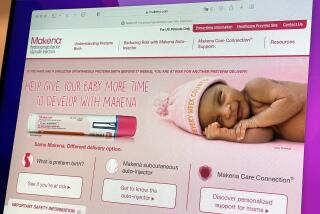FDA Urged to Keep Acne Medications on Market
- Share via
BETHESDA, Md. — Medical experts advised the government on Friday that the benefits of an ingredient in popular acne medicines outweigh the possible risk of getting cancer from it, and it should be available without a prescription.
Advisers to the Food and Drug Administration said the ingredient, benzoyl peroxide, could remain on the market while new animal studies are being conducted. The vote was unanimous.
Benzoyl peroxide is found in such products as Clearasil, Oxy-5 and Oxy-10.
“I have absolutely no hesitancy in using this product,” Dr. Sidney Hurwitz, clinical professor of pediatrics and dermatology at the Yale University School of Medicine, told the panel.
Benzoyl peroxide, which has been sold over the counter for some 30 years, has been found effective in killing the bacteria p. acnes , a cause of pimples and chronic acne.
Its use came into question when studies found that lab rodents developed cancerous tumors when this compound was applied to the skin or given orally.
However, industry scientists said the dosages given to the rodents were massive and that some of the rodents were bred to be especially sensitive to getting cancerous growths.
Acne products not needing a prescription accounted for some $300 million in annual sales, and products containing benzoyl peroxide accounted for about a third of that, said Debra Bennetts, a spokeswoman for Proctor & Gamble.
Hurwitz, who was speaking on behalf of the American Academy of Dermatology, told the panel that use of the preparation is so widespread that it would be impractical to require people with pimples to get a prescription before buying a tube of cream. Doctors’ offices would be overwhelmed, he said.
Albert Kraus, a toxicologist for Procter & Gamble, said the studies using the lab animals gave some of them 13,000 to 30,000 times the lifetime dose a human could expect to take.
“Those were sufficient to take the hair off those animals.”
But members of the FDA panel, most of whom are dermatologists with experience in treating acne, question whether Kraus’ estimates of a human lifetime dose were low.
The industry wanted to impress the panel on the need for acne medication.
Slides shown to the panel demonstrated how disfiguring this condition can be. A mild case showed the profile of a girl with a few pimples on her cheek. A slide of a moderate case looked worse, and one of a severe case made people in the room gasp.
It showed a fellow wearing glasses but no shirt, smiling rather wanly into the lens. His shoulders and chest were covered with raw, bloody lesions.






